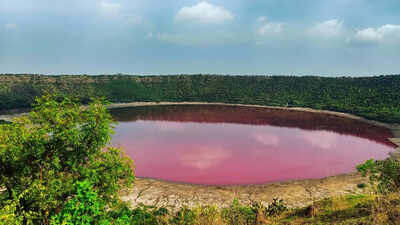ARTICLE AD BOX

Our planet Earth, as mesmerising it is, never fails to throw in things that baffle humans every now and then. It’s as if to remind us humans, “look, what I can do!” One such incredible thing is lakes that change colour with seasons.
It’s not just one or two, in fact, there are many such lakes around the world. It’s no sorcery. These lakes transform dramatically with the seasons due to factors like algal blooms, mineral shifts, glacial melt, sunlight angles, and weather patterns. When these changes occur, they turn serene waters into vibrant spectacles, from turquoise to pink or emerald to red.
Kelimutu Lakes, Indonesia
Nestled in the craters of Mount Kelimutu on Flores Island, these three volcanic lakes—Tiwi Ata Mbupu (Lake of Old People), Tiwu Nua Muri Kooh Tai (Lake of Young People), and Tiwu Ata Polo (Bewitched Lake)—go from turquoise to green to black, red, and brown.
The changes are unpredictable, and they happen every few years or so. The changes occur due to seasonal volcanic gases, mineral oxidation, and rainwater dilution.
Lake Retba (Lac Rose), Senegal
This hypersaline coastal lake near Dakar glows bubblegum pink during the dry season (November–June). The reason, you ask? It’s due to the presence of Dunaliella salina algae that produces beta-carotene pigment for protection against high salt levels.
When it rains, the rainwater dilutes the lake water, which then reduces salinity. This causes slowing down of algae production. When this happens, the water slowly turns from pink to a more subdued blue or clear tone.

Lake Natron, Tanzania
This soda lake in the Arusha Region turns rusty red or pink during the dry season (June–October) from blooming halophilic algae and spirulina, attracting massive flamingo flocks. In the wet season (November–May), it dilutes to a greyish or clear state as rainfall lowers alkalinity, reducing the microbial activity that drives the bold colors.
Plitvice Lakes, Croatia
A UNESCO World Heritage site with 16 cascading lakes in Plitvice National Park, these waters change from azure blue in spring to emerald green in summer. The former is due to snowmelt and minerals, and the latter, due to algae and sunlight. Come autumn, the waters have greyish tones due to fewer organisms and overcast skies.
Laguna Colorada, Bolivia
Up In the Andean highlands of Eduardo Avaroa National Park, this shallow salt lake appears fiery red in the dry season (May–November) from red algae and sediments stirred by wind.
But come monsoon, the same lake turns pale to white, brown, or even orange.
Lonar Lake, India
This saline and alkaline crater lake in Maharashtra's Buldhana district, formed by a meteorite impact 50,000 years ago, typically appears green but can dramatically turn pink during the dry season (late winter to early summer) due to increased salinity from evaporation, promoting blooms of salt-loving Haloarchaea microbes that produce carotenoid pigments. In the rainy season (June–September), dilution from monsoon rains restores it to green.



.png)
.png)
.png)
















 1 hour ago
4
1 hour ago
4








 English (US) ·
English (US) ·